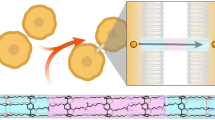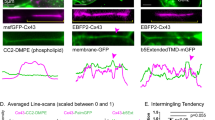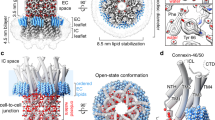Abstract
Intercellular junctional communication is very common in normal organized tissue1. It provides a pathway for transmission of electrical signals, especially in heart muscle2,3, and may be important in differentiation and growth control1,4. The hydrophilic channels which enable cell–cell communication have been well characterized by biophysical methods5,6, and there is now good evidence that they are contained in the nexus (gap junctions)3,7–9. Little, however, is known about the molecular mechanism of biosynthesis of junctional channels. Knowledge in this area has been obtained almost exclusively from experiments with reaggregated cells10–15, a system complicated by the fact that de novo synthesis of channel proteins is obscured by reassembly of pre-existing subunits or utilization of precursors. To avoid these problems, we have now isolated mRNA from cells that are in the process of making new intercellular nexus with high efficiency, incorporated it via liposomes into communication-defective cells and have shown that the recipient cells established junctional communication.
This is a preview of subscription content, access via your institution
Access options
Subscribe to this journal
Receive 51 print issues and online access
$199.00 per year
only $3.90 per issue
Buy this article
- Purchase on Springer Link
- Instant access to full article PDF
Prices may be subject to local taxes which are calculated during checkout
Similar content being viewed by others
References
Loewenstein, W. R. Biochim. biophys. Acta 560, 1–65 (1979).
Weidmann, S. J. Physiol., Land. 118, 348–360 (1952).
Barr, L., Dewey, M. M. & Berger, W. J. gen. Physiol. 48, 797–823 (1965).
Loewenstein, W. R. Devi Biol. 19, Suppl. 2, 151–183 (1968).
Loewenstein, W. R. Cold Spring Harb. Symp. quant. Biol. 40, 49–63 (1975).
Flagg-Newton, J., Simpson, I. & Loewenstein, W. R. Science 205, 404–407 (1979).
McNutt, N. S. & Weinstein, R. S. Prog. Biophys. molec. Biol. 26, 45–101 (1973).
Caspar, D. L. D., Goodenough, D. A., Malkowsky, L. & Phillips, W. C. J. Cell Biol. 74, 605–628 (1977).
Unwin, P. N. T. & Zampighi, G. Nature 283, 545–549 (1980).
Loewenstein, W. R. Devl Biol. 15, 503–520 (1967).
Ito, S., Sato, E. & Loewenstein, W. R. J. Membrane Biol. 19, 305–337 (1974).
DeHaan, R. L. & Hirakow, R. Expl Cell Res. 70, 214–220 (1972).
Hammer, M., Epstein, M. & Shridan, J. J. Cell Biol. 59, 130a (1973).
Epstein, M. L., Sheridan, J. D. & Johnson, R. G. Expl Cell Res. 104, 25–30 (1977).
Griepp, E. B. & Bernfield, M. R. Circulation 52, Suppl. 2, 106 (1975).
Dahl, G. & Berger, W. Cell Biol. int. Rep. 2, 381–387 (1978).
Garfield, R. E., Sims, S. M., Kannan, M. S. & Daniel, E. E. Am. J. Physiol. 235, C168–C179 (1978).
Merk, F. B., Botticelli, C. R. & Albright, J. T. Endocrinology 90, 992–1007 (1972).
Decker, R. S. J. Cell Biol. 69, 669–685 (1976).
Decker, R. S., Donta, S. T., Larsen, W. J. & Murray, S. A. J. supramolec. Struct. 9, 497–507 (1978).
Henderson, D., Eibl, H. & Weber, K. J. molec. Biol. 132, 193–218 (1979).
Hertzberg, E. L. & Gilula, N. B. J. biol. Chem. 254, 2138–2147 (1979).
Finbow, M., Yancey, S. B., Johnson, R. & Revel, J. P. Proc. natn. Acad. Sci. U.S.A. 77, 970–974 (1980).
Szoka, F. & Papahadjopoulos, D. Proc. natn. Acad. Sci. U.S.A. 75, 4194–4198 (1978).
Azarnia, R., Larsen, W. J. & Loewenstein, W. R. Proc natn. Acad. Sci. U.S.A. 71, 880–884 (1974).
Rash, J. E. & Fambrough, D. Devi Biol. 30, 168–186 (1973).
Chirgwin, J. M., Przybyla, A. E., MacDonald, R. J. & Rutter, W. J. Biochemistry 18, 5294–5299 (1979).
Kryxtosek, A., Cawthon, M. L. & Kabat, D. J. biol. Chem. 250, 6077–6084 (1975).
Pauli, B. K., Weinstein, R. S., Soble, L. W. & Alroy, J. J. Cell Biol. 72, 763–769 (1977).
Author information
Authors and Affiliations
Rights and permissions
About this article
Cite this article
Dahl, G., Azarnia, R. & Werner, R. Induction of cell–cell channel formation by mRNA. Nature 289, 683–685 (1981). https://doi.org/10.1038/289683a0
Received:
Accepted:
Issue Date:
DOI: https://doi.org/10.1038/289683a0
This article is cited by
-
Gap junctions remain open during cytochrome c-induced cell death: relationship of conductance to ‘bystander’ cell killing
Cell Death & Differentiation (2006)
-
Intercellular communication between cultured granulosa cells of the marmoset (Callithrix jacchus)
Cell & Tissue Research (1992)
-
Use ofXenopus oocytes for the functional expression of plasma membrane proteins
The Journal of Membrane Biology (1990)
-
Structure of a gap junction gene: Rat connexin-32
Bioscience Reports (1988)
-
Translation and functional expression of cell-cell channel mRNA inXenopus oocytes
The Journal of Membrane Biology (1985)
Comments
By submitting a comment you agree to abide by our Terms and Community Guidelines. If you find something abusive or that does not comply with our terms or guidelines please flag it as inappropriate.



